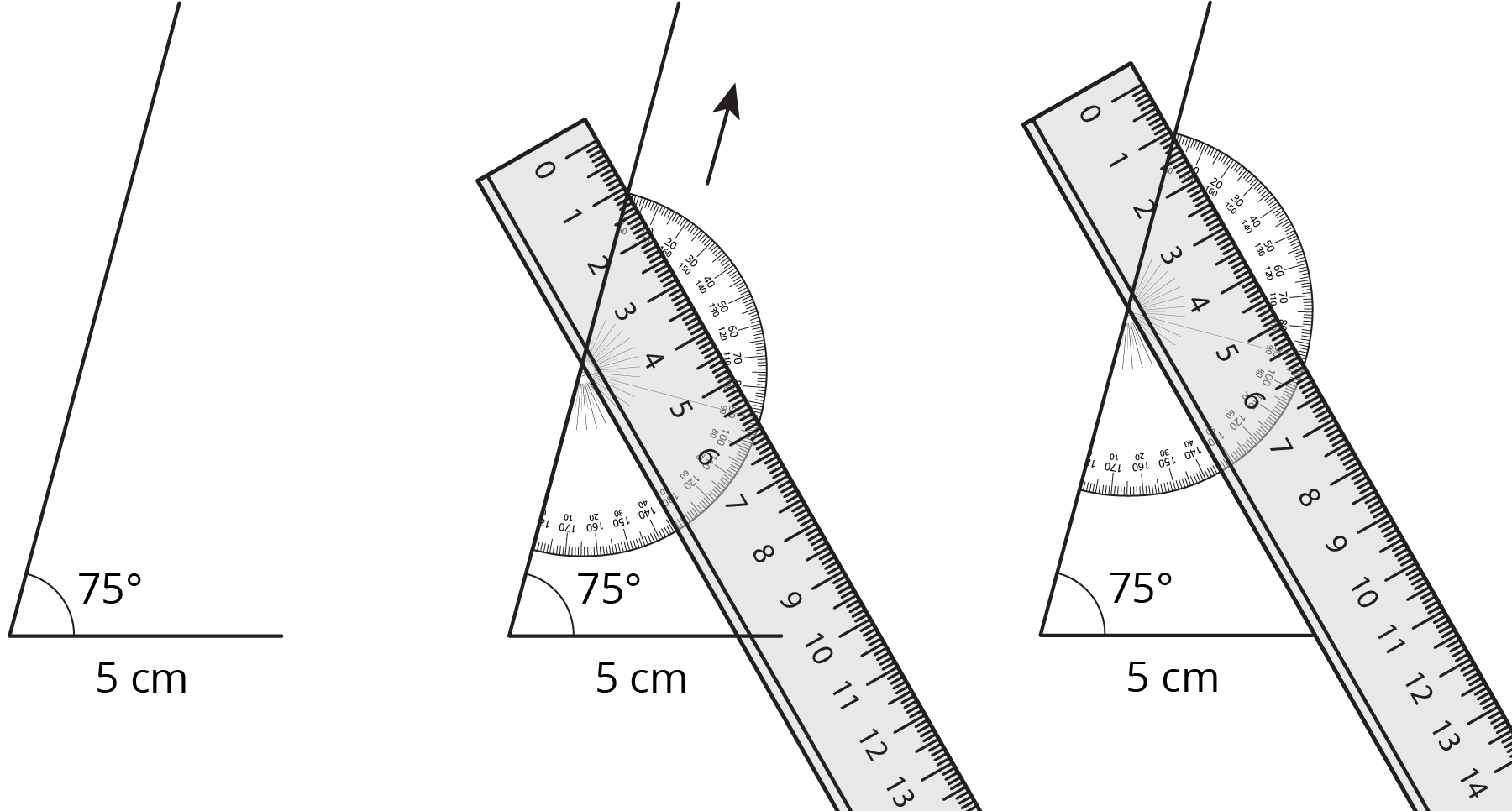Lesson 17
Drawing Triangles
17.1: Using a Compass to Estimate Length (5 minutes)
Warm-up
The purpose of this warm-up is to remind students that a compass is useful for transferring a length in general, and not just for drawing circles. As students discuss answers with their partners, monitor for students who can clearly explain how they can use the compass to compare the length of the third side.
Launch
Arrange students in groups of 2. Give students 2 minutes of quiet work time followed by time to discuss their answers with their partner. Follow with a whole-class discussion. Provide access to geometry toolkits and compasses.
Student Facing
- Draw a \(40^\circ\) angle.
- Use a compass to make sure both sides of your angle have a length of 5 centimeters.
-
If you connect the ends of the sides you drew to make a triangle, is the third side longer or shorter than 5 centimeters? How can you use a compass to explain your answer?
Student Response
For access, consult one of our IM Certified Partners.
Activity Synthesis
Ask previously identified students to share their responses to the final question. Display their drawing of the angle for all to see. If not mentioned in students’ explanations, demonstrate for all to see how to use the compass to estimate the length of the third side of the triangle.
17.2: How Many Can You Draw? (15 minutes)
Activity
In this activity, students are asked to draw as many different triangles as they can with the given conditions. The purpose of this activity is to provide an opportunity for students to see the three main results for this unit: a situation in which only a unique triangle can be made, a situation in which it is impossible to create a triangle from the given conditions, and a situation in which multiple triangles can be created from the conditions.
Students are not expected to remember which conditions lead to which results, but should become more familiar with some methods for attempting to create different triangles. They will practice including various conditions into the triangles, including the conditions in different combinations, and recognizing when the resulting triangles are identical copies or not.
The activity synthesis references a previous activity which is not included in IM 6–8 Math Accelerated. If time allows, demonstrate for students that one way to draw a triangle (Lin's method) with one angle measuring \(60^\circ\), one angle measuring \(90^\circ\), and one side measuring 4 cm is to:
- Draw the 4 cm segment.
- Draw the \(60^\circ\) angle on one end of the segment, with a very long ray.
- Place a protractor along the ray.
- Line up a ruler at the \(90^\circ\) measure on the protractor.
- Keeping the ruler and protractor together, slide them along the ray until the edge of the ruler intersects with the other end of the 4 cm segment.
- Keeping the ruler in place on the paper, remove the protractor from underneath.
- Draw a line along the ruler from the ray to the segment.
Here is an image showing what this would look like for a triangle with one angle measuring \(75^\circ\), one angle measuring \(45^\circ\), and one side measuring 5 cm:

Launch
Keep students in same groups. Tell students they must try at least two different times to draw a triangle with the measurements given in each problem. Give students 5 minutes of quiet work time followed by time to discuss their different triangles with a partner. Follow with a whole-class discussion. Provide access to geometry toolkits.
Supports accessibility for: Language; Organization
Student Facing
-
Draw as many different triangles as you can with each of these sets of measurements:
- Two angles measure \(60^\circ\), and one side measures 4 cm.
- Two angles measure \(90^\circ\), and one side measures 4 cm.
- One angle measures \(60^\circ\), one angle measures \(90^\circ\), and one side measures 4 cm.
-
Which sets of measurements determine one unique triangle? Explain or show your reasoning.
Student Response
For access, consult one of our IM Certified Partners.
Launch
Keep students in same groups. Tell students they must try at least two different times to draw a triangle with the measurements given in each problem. Give students 5 minutes of quiet work time followed by time to discuss their different triangles with a partner. Follow with a whole-class discussion. Provide access to geometry toolkits.
Supports accessibility for: Language; Organization
Student Facing
-
Draw as many different triangles as you can with each of these sets of measurements:
-
Two angles measure \(60^\circ\), and one side measures 4 cm.
-
Two angles measure \(90^\circ\), and one side measures 4 cm.
-
One angle measures \(60^\circ\), one angle measures \(90^\circ\), and one side measures 4 cm.
-
-
Which of these sets of measurements determine one unique triangle? Explain or show your reasoning.
Student Response
For access, consult one of our IM Certified Partners.
Student Facing
Are you ready for more?

In the diagram, 9 toothpicks are used to make three equilateral triangles. Figure out a way to move only 3 of the toothpicks so that the diagram has exactly 5 equilateral triangles.
Student Response
For access, consult one of our IM Certified Partners.
Anticipated Misconceptions
Some students may draw two different orientations of the same triangle for the third set of conditions, with the 4 cm side in between the \(60^\circ\) and \(90^\circ\) angles. Prompt them to use tracing paper to check whether their two triangles are really different (not identical copies).
Some students may say the third set of measurements determines one unique triangle, because they assume the side length must go between the two given angle measures. Remind them of the discussion about Lin’s triangle in the previous activity.
Activity Synthesis
Ask students to indicate how many different triangles (triangles that are not identical copies) they could draw for each set of conditions. Select students to share their drawings and reasoning about the uniqueness of each problem. Discuss methods students used to try to think about other triangles that might fit the conditions.
Consider asking some of the following questions:
- “Which conditions produced a unique triangle?” (the first set of conditions)
- “Were there conditions that produced more than one triangle?” (the third set of conditions)
- “Were there conditions you could not draw a triangle for?” (the second set of conditions)
- “Why could you not draw a triangle for the second set of conditions?” (because two sides are parallel and will never intersect)
If not mentioned by students, explain to students that for the third set of conditions it is possible that all students drew identical copies using the 4 cm length as the side between the \(60^\circ\) and \(90^\circ\) angles. Consider asking them to think of the previous activity and to try to draw the triangle the way Lin would.
In grade 7, students do not need to know that the angles within a triangle sum to \(180^\circ\). Tell them that next year they will learn more about why these different conditions determine different numbers of triangles.
Design Principle(s): Maximize meta-awareness; Support sense-making
17.3: Revisiting How Many Can You Draw? (15 minutes)
Activity
Launch
Arrange students in groups of 2. Provide access to geometry toolkits and compasses. Remind students of the activity in a previous lesson where they used the strips and fasteners to draw triangles on their paper. Ask what other tool also helps you find all the points that are a certain distance from a center point (a compass). Tell students that they should attempt to create a triangle with the given specifications. If they can create one, they should attempt to either create at least one more triangle not congruent to the first or justify to themselves why there is only one. If they cannot create any, they should show some valid attempts to include as many pieces as they can and be ready to explain why they cannot include the remaining conditions.
Give students 7–8 minutes of partner work time, followed by a whole-class discussion.
If using the digital lesson, students should still try to create a triangle with the given specifications. If they can create one, they should attempt to either create at least one more or justify to themselves why there is only one. If they cannot create any, they should be ready to explain some of their attempts and why they cannot include the remaining conditions.
Design Principle(s): Maximize meta-awareness; Cultivate conversation
Student Facing
Use an applet to draw triangles. Sides can overlap.
- Draw as many different triangles as you can with this set of measurements.
- One angle measures \(40^\circ\), one side measures 4 cm, and one side measures 5 cm.
- Do these measurements determine one unique triangle? How do you know?
- Draw as many different triangles as you can with each of these sets of angle measurements. Do either of these sets of measurements determine one unique triangle? Explain how do you know.
- One angle measures \(50^\circ\), one measures \(60^\circ\), and one measures \(70^\circ\).
- One angle measures \(50^\circ\), one measures \(60^\circ\), and one measures \(100^\circ\).
Student Response
For access, consult one of our IM Certified Partners.
Student Facing
Are you ready for more?
Using only the point, segment, and compass tools provided, create an equilateral triangle. You are only successful if the triangle remains equilateral while dragging its vertices around.
Student Response
For access, consult one of our IM Certified Partners.
Launch
Arrange students in groups of 2. Provide access to geometry toolkits and compasses. Remind students of the activity in a previous lesson where they used the strips and fasteners to draw triangles on their paper. Ask what other tool also helps you find all the points that are a certain distance from a center point (a compass). Tell students that they should attempt to create a triangle with the given specifications. If they can create one, they should attempt to either create at least one more triangle not congruent to the first or justify to themselves why there is only one. If they cannot create any, they should show some valid attempts to include as many pieces as they can and be ready to explain why they cannot include the remaining conditions.
Give students 7–8 minutes of partner work time, followed by a whole-class discussion.
If using the digital lesson, students should still try to create a triangle with the given specifications. If they can create one, they should attempt to either create at least one more or justify to themselves why there is only one. If they cannot create any, they should be ready to explain some of their attempts and why they cannot include the remaining conditions.
Design Principle(s): Maximize meta-awareness; Cultivate conversation
Student Facing
- Draw as many different triangles as you can with this set of measurements.
- One angle measures \(40^\circ\), one side measures 4 cm, and one side measures 5 cm.
- Do these measurements determine one unique triangle? How do you know?
- Draw as many different triangles as you can with each of these sets of angle measurements. Do either of these sets of measurements determine one unique triangle? Explain how do you know.
- One angle measures \(50^\circ\), one measures \(60^\circ\), and one measures \(70^\circ\).
- One angle measures \(50^\circ\), one measures \(60^\circ\), and one measures \(100^\circ\)
Student Response
For access, consult one of our IM Certified Partners.
Student Facing
Are you ready for more?
Using only a compass and the edge of a blank index card, draw a perfectly equilateral triangle. (Note! The tools are part of the challenge! You may not use a protractor! You may not use a ruler!)
Student Response
For access, consult one of our IM Certified Partners.
Anticipated Misconceptions
If students struggle to create more than one triangle from the first set of conditions, prompt them to write down the order they already used for their measurements and then brainstorm other possible orders they could use.
If students struggle to get started, remind them of the technique shared at the end of the previous activity of using the protractor and a ruler to make an angle that can move along a line.
Activity Synthesis
Select students to share how many different triangles they were able to draw with each set of conditions.
If not brought up in student explanations, point out that for the first problem, one possible order for the measurements (\(40^\circ\), 5 cm, 4 cm) can result in two different triangles (the bottom two in the solution image). One way to show this is to draw a 5 cm segment and then use a compass to draw a circle with a 4 cm radius centered on the segment’s left endpoint. Next, draw a ray at a \(40^\circ\) angle centered on the segment’s right endpoint. Notice that this ray intersects the circle twice. Each one of these points could be the third vertex of the triangle. While it is helpful for students to notice this interesting aspect of their drawing, it is not important for students to learn rules about the number of possible triangles given different sets of conditions.
If students do not touch on the scaled triangles created by the same three angles, ask, “Why is there more than one triangle that can be made with the measurements in the first problem?” (Because there are no side lengths mentioned, so we can create smaller or larger copies of the triangles with the same angles but with shorter or longer side lengths.) Students begin their study of scaled copies in the next unit, so their work on this question is a sneak peak of the work ahead.
MLR 1 (Stronger and Clearer Each Time): Before discussing the second set of conditions as a whole class, have student pairs share their reasoning for why there were no triangles that could be drawn with the given measures, with two different partners in a row. Have students practice using mathematical language to be as clear as possible when sharing with the class, when and if they are called upon.
Supports accessibility for: Attention; Social-emotional skills
Lesson Synthesis
Lesson Synthesis
Here are some questions for discussion:
- “How was a compass useful in drawing triangles today?” (It helps find all the points a certain distance away.)
- “What strategies did you use to include two given side lengths and a given angle?” (Draw one of the side lengths and use a protractor to draw the angle at one end, then use a compass to finish the picture.)
- “What strategies did you use to include three given angles?” (Draw one angle then use a protractor and ruler to slide along one side of the first angle.)
17.4: Cool-down - Finishing Noah’s Triangle (5 minutes)
Cool-Down
For access, consult one of our IM Certified Partners.
Student Lesson Summary
Student Facing
A triangle has six measures: three side lengths and three angle measures.
If we are given three measures, then sometimes, there is no triangle that can be made. For example, there is no triangle with side lengths 1, 2, 5, and there is no triangle with all three angles measuring \(150^\circ\).

Sometimes, only one triangle can be made. By this we mean that any triangle we make will be the same, having the same six measures. For example, if a triangle can be made with three given side lengths, then the corresponding angles will have the same measures. Another example is shown here: an angle measuring \(45^\circ\) between two side lengths of 6 and 8 units. With this information, one unique triangle can be made.

Sometimes, two or more different triangles can be made with three given measures. For example, here are two different triangles that can be made with an angle measuring \(45^\circ\) and side lengths 6 and 8. Notice the angle is not between the given sides.

Three pieces of information about a triangle’s side lengths and angle measures may determine no triangles, one unique triangle, or more than one triangle. It depends on the information.